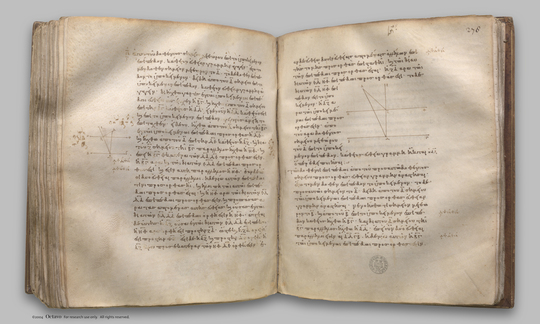index prev next | digilib folio 282

From a given elevated point to draw a straight line perpendicular to a given plane.
| Ἀπὸ τοῦ δοθέντος σημείου μετεώρου ἐπὶ τὸ δοθὲν ἐπίπεδον κάθετον εὐθεῖαν γραμμὴν ἀγαγεῖν. Ἔστω τὸ μὲν δοθὲν σημεῖον μετέωρον τὸ Α, τὸ δὲ δοθὲν ἐπίπεδον τὸ ὑποκείμενον: δεῖ δὴ ἀπὸ τοῦ Α σημείου ἐπὶ τὸ ὑποκείμενον ἐπίπεδον κάθετον εὐθεῖαν γραμμὴν ἀγαγεῖν. Διήχθω γάρ τις ἐν τῷ ὑποκειμένῳ ἐπιπέδῳ εὐθεῖα, ὡς ἔτυχεν, ἡ ΒΓ, καὶ ἤχθω ἀπὸ τοῦ Α σημείου ἐπὶ τὴν ΒΓ κάθετος ἡ ΑΔ. εἰ μὲν οὖν ἡ ΑΔ κάθετός ἐστι καὶ ἐπὶ τὸ ὑποκείμενον ἐπίπεδον, γεγονὸς ἂν εἴη τὸ ἐπιταχθέν. εἰ δὲ οὔ, ἤχθω ἀπὸ τοῦ Δ σημείου τῇ ΒΓ ἐν τῷ ὑποκειμένῳ ἐπιπέδῳ πρὸς ὀρθὰς ἡ ΔΕ, καὶ ἤχθω ἀπὸ τοῦ Α ἐπὶ τὴν ΔΕ κάθετος ἡ ΑΖ, καὶ διὰ τοῦ Ζ σημείου τῇ ΒΓ παράλληλος ἤχθω ἡ ΗΘ. Καὶ ἐπεὶ ἡ ΒΓ ἑκατέρᾳ τῶν ΔΑ, ΔΕ πρὸς ὀρθάς ἐστιν, ἡ ΒΓ ἄρα καὶ τῷ διὰ τῶν ΕΔΑ ἐπιπέδῳ πρὸς ὀρθάς ἐστιν. καί ἐστιν αὐτῇ παράλληλος ἡ ΗΘ: ἐὰν δὲ ὦσι δύο εὐθεῖαι παράλληλοι, ἡ δὲ μία αὐτῶν ἐπιπέδῳ τινὶ πρὸς ὀρθὰς ᾖ, καὶ ἡ λοιπὴ τῷ αὐτῷ ἐπιπέδῳ πρὸς ὀρθὰς ἔσται: καὶ ἡ ΗΘ ἄρα τῷ διὰ τῶν ΕΔ, ΔΑ ἐπιπέδῳ πρὸς ὀρθάς ἐστιν. καὶ πρὸς πάσας ἄρα τὰς ἁπτομένας αὐτῆς εὐθείας καὶ οὔσας ἐν τῷ διὰ τῶν ΕΔ, ΔΑ ἐπιπέδῳ ὀρθή ἐστιν ἡ ΗΘ. ἅπτεται δὲ αὐτῆς ἡ ΑΖ οὖσα ἐν τῷ διὰ τῶν ΕΔ, ΔΑ ἐπιπέδῳ: ἡ ΗΘ ἄρα ὀρθή ἐστι πρὸς τὴν ΖΑ: ὥστε καὶ ἡ ΖΑ ὀρθή ἐστι πρὸς τὴν ΘΗ. ἔστι δὲ ἡ ΑΖ καὶ πρὸς τὴν ΔΕ ὀρθή: ἡ ΑΖ ἄρα πρὸς ἑκατέραν τῶν ΗΘ, ΔΕ ὀρθή ἐστιν. ἐὰν δὲ εὐθεῖα δυσὶν εὐθείαις τεμνούσαις ἀλλήλας ἐπὶ τῆς τομῆς πρὸς ὀρθὰς ἐπισταθῇ, καὶ τῷ δι' αὐτῶν ἐπιπέδῳ πρὸς ὀρθὰς ἔσται: ἡ ΖΑ ἄρα τῷ διὰ τῶν ΕΔ, ΗΘ ἐπιπέδῳ πρὸς ὀρθάς ἐστιν. τὸ δὲ διὰ τῶν ΕΔ, ΗΘ ἐπίπεδόν ἐστι τὸ ὑποκείμενον: ἡ ΑΖ ἄρα τῷ ὑποκειμένῳ ἐπιπέδῳ πρὸς ὀρθάς ἐστιν. Ἀπὸ τοῦ ἄρα δοθέντος σημείου μετεώρου τοῦ Α ἐπὶ τὸ ὑποκείμενον ἐπίπεδον κάθετος εὐθεῖα γραμμὴ ἦκται ἡ ΑΖ: ὅπερ ἔδει ποιῆσαι. | From a given elevated point to draw a straight line perpendicular to a given plane. Let A be the given elevated point, and the plane of reference the given plane; thus it is required to draw from the point A a straight line perpendicular to the plane of reference. Let any straight line BC be drawn, at random, in the plane of reference, and let AD be drawn from the point A perpendicular to BC. [I. 12] If then AD is also perpendicular to the plane of reference, that which was enjoined will have been done. But, if not, let DE be drawn from the point D at right angles to BC and in the plane of reference, [I. 11] let AF be drawn from A perpendicular to DE, [I. 12] and let GH be drawn through the point F parallel to BC. [I. 31] Now, since BC is at right angles to each of the straight lines DA, DE, therefore BC is also at right angles to the plane through ED, DA. [XI. 4] And GH is parallel to it; but, if two straight lines be parallel, and one of them be at right angles to any plane, the remaining one will also be at right angles to the same plane; [XI. 8] therefore GH is also at right angles to the plane through ED, DA. Therefore GH is also at right angles to all the straight lines which meet it and are in the plane through ED, DA. [XI. Def. 3] But AF meets it and is in the plane through ED, DA; therefore GH is at right angles to FA, so that FA is also at right angles to GH. But AF is also at right angles to DE; therefore AF is at right angles to each of the straight lines GH, DE. But, if a straight line be set up at right angles to two straight lines which cut one another, at the point of section, it will also be at right angles to the plane through them; [XI. 4] therefore FA is at right angles to the plane through ED, GH. But the plane through ED, GH is the plane of reference; therefore AF is at right angles to the plane of reference. |